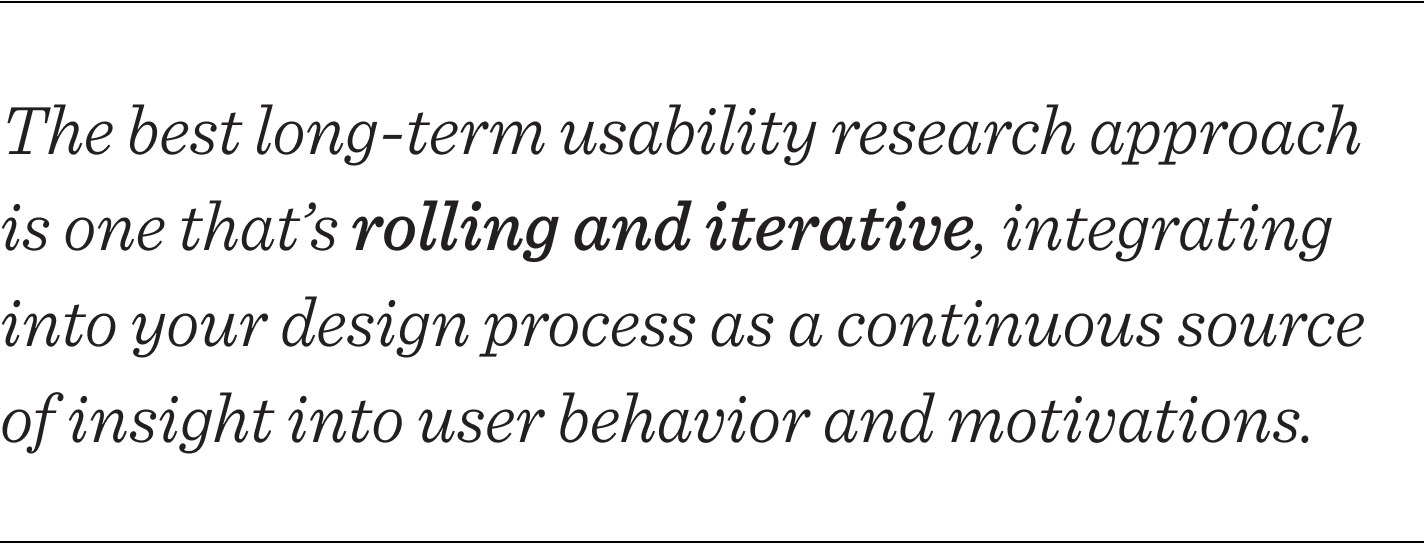Design thinking in the Age of AI
AI is transforming how we live, work, and communicate. With AI’s help, we can move from idea to product launch at super-speed. Never before have we been able to move
▪ September 26, 2025▪ October 14, 2021
Usability research to understand the experience people first have with your digital product provides great insight into users’ initial friction points and perceptions. It can help identify immediate usability issues, information gaps and value proposition disconnects that act as barriers to building trust and getting your customers started off on the right foot.
The trouble is, many of today’s digital products and services are designed for user engagement beyond the initial moment of conversion or onboarding. As a result, these products need to consider a much bigger time frame of the user’s experience. Your product is likely one of them.
Sticking strictly to one-time, first-impression usability testing may be why you haven’t discovered specific issues that cause users to abandon your product over time.

It’s time for a different approach to understanding ongoing product use. One that gives you a holistic picture of how your users use your product long-term. The result will be a more comprehensive view of the user experience, allowing you to make design decisions that build meaningful engagement with your customers over the long haul.
First-impression usability testing is undoubtedly essential, but for products designed to support users beyond one-time interactions, this approach to usability research doesn’t tell you everything.
Specifically, first-impression usability testing misses the time frame and context complexities inherent in common digital products:

These product time frames and unique contexts influence how your customers use and value your product over time. As a result, they have critical implications on how they come to love — or not love — your product. Not factoring longer-term time frames into your research approach can leave significant insights out of the picture.
Just like your product is one-of-a-kind, your approach for assessing long-term usability will be, too. With that in mind, consider these specific details about your product before crafting your approach.
Aside from your product, be mindful of your process and timing for sharing insights and brainstorming implications with your product team along the way. Based on what you learn from users, you’ll adjust your research plan to explore different questions and needs your product team is exploring. You’ll discover the areas where you want to dig deeper and when to zero in on a certain feature.

With your specific factors in mind, you can determine how you’ll gather data on long-term use of your product. Cast a wide net of methods you consider and get creative about how they can be used in different ways.
Scenario 1. Research with one set of users over time. One approach could be exploring research methods that focus on gathering data from a single set of existing users across a dedicated time frame. Methods could include a longitudinal diary study or lighter-lift usability “snapshot” surveys sent at different intervals in their health journey. Following one set of users you’ll be able to observe how their specific needs and product usage change over time.
Scenario 2. Research with a time-based cross-section of users. Alternatively, you could segment your users by the different stages of diagnoses and run shorter research activities with users from each group. Examples of methods include a product usage and feedback survey of users at all stages, or more focused, moderated “show and tell” usability interviews with a representative sample at each stage. Conducting research with time-based cross sections of users will help paint a picture of the broader user experience across stages.

There will always be trade-offs to one data-gathering approach versus another. Brainstorming options will help you determine the best approach with your product considerations and project constraints in mind.
There’s no one-size-fits-all long-term usability research approach. Of course, your table stakes for actionable insights include involving real users in real contexts. Figuring out just the right approach will take work to hone in on what is best for your product.

As you adopt your new approach to long-term usability research, you may encounter setbacks. What matters is you keep going, keep learning, and keep discovering. Making the necessary tweaks now will help you grow a repeatable strategy for gathering insightful user data over time.
Everyday Industries is a UX strategy and digital product design firm. See how our UX research services can give you an in-depth understanding of how your product can best meet customers’ needs and expectations.
AI is transforming how we live, work, and communicate. With AI’s help, we can move from idea to product launch at super-speed. Never before have we been able to move
▪ September 26, 2025Customer journey maps for wellness tech products are powerful tools to strengthen the digital experience and increase adoption. No matter where you are in developing your product, you can use strategies to uncover and shape the customer journey to ensure the most important elements of the experience are accounted for and thoughtfully defined.
▪ February 16, 2024If your goal is a user-centered product, analysis of your user research is an important step in defining the details that will align your product with users’ needs. Learn a process for data analysis that will make decision-making and design more effective.
▪ December 7, 2023